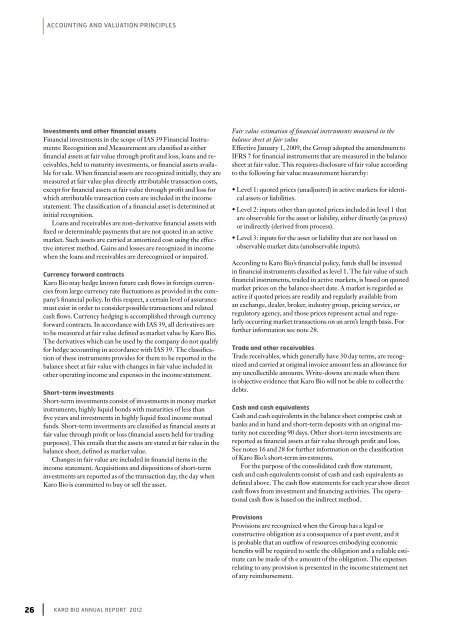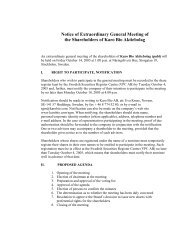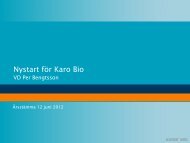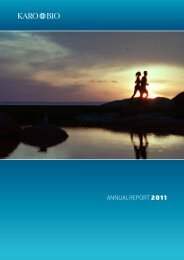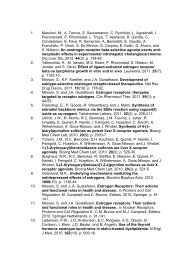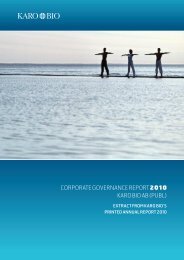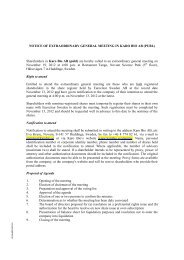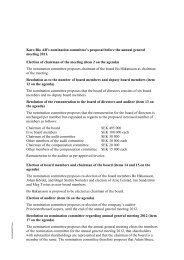Annual Report 2012.pdf - Karo Bio
Annual Report 2012.pdf - Karo Bio
Annual Report 2012.pdf - Karo Bio
Create successful ePaper yourself
Turn your PDF publications into a flip-book with our unique Google optimized e-Paper software.
Accounting and valuation principles<br />
Investments and other financial assets<br />
Financial investments in the scope of IAS 39 Financial Instruments:<br />
Recognition and Measurement are classified as either<br />
financial assets at fair value through profit and loss, loans and receivables,<br />
held to maturity investments, or financial assets available<br />
for sale. When financial assets are recognized initially, they are<br />
measured at fair value plus directly attributable transaction costs,<br />
except for financial assets at fair value through profit and loss for<br />
which attributable transaction costs are included in the income<br />
statement. The classification of a financial asset is determined at<br />
initial recognition.<br />
Loans and receivables are non-derivative financial assets with<br />
fixed or determinable payments that are not quoted in an active<br />
market. Such assets are carried at amortized cost using the effective<br />
interest method. Gains and losses are recognized in income<br />
when the loans and receivables are derecognized or impaired.<br />
Currency forward contracts<br />
<strong>Karo</strong> <strong>Bio</strong> may hedge known future cash flows in foreign currencies<br />
from large currency rate fluctuations as provided in the company’s<br />
financial policy. In this respect, a certain level of assurance<br />
must exist in order to consider possible transactions and related<br />
cash flows. Currency hedging is accomplished through currency<br />
forward contracts. In accordance with IAS 39, all derivatives are<br />
to be measured at fair value defined as market value by <strong>Karo</strong> <strong>Bio</strong>.<br />
The derivatives which can be used by the company do not qualify<br />
for hedge accounting in accordance with IAS 39. The classification<br />
of these instruments provides for them to be reported in the<br />
balance sheet at fair value with changes in fair value included in<br />
other operating income and expenses in the income statement.<br />
Short-term investments<br />
Short-term investments consist of investments in money market<br />
instruments, highly liquid bonds with maturities of less than<br />
five years and investments in highly liquid fixed income mutual<br />
funds. Short-term investments are classified as financial assets at<br />
fair value through profit or loss (financial assets held for trading<br />
purposes). This entails that the assets are stated at fair value in the<br />
balance sheet, defined as market value.<br />
Changes in fair value are included in financial items in the<br />
income statement. Acquisitions and dispositions of short-term<br />
investments are reported as of the transaction day, the day when<br />
<strong>Karo</strong> <strong>Bio</strong> is committed to buy or sell the asset.<br />
Fair value estimation of financial instruments measured in the<br />
balance sheet at fair value<br />
Effective January 1, 2009, the Group adopted the amendment to<br />
IFRS 7 for financial instruments that are measured in the balance<br />
sheet at fair value. This requires disclosure of fair value according<br />
to the following fair value measurement hierarchy:<br />
• Level 1: quoted prices (unadjusted) in active markets for identical<br />
assets or liabilities.<br />
• Level 2: inputs other than quoted prices included in level 1 that<br />
are observable for the asset or liability, either directly (as prices)<br />
or indirectly (derived from process).<br />
• Level 3: inputs for the asset or liability that are not based on<br />
observable market data (unobservable inputs).<br />
According to <strong>Karo</strong> <strong>Bio</strong>’s financial policy, funds shall be invested<br />
in financial instruments classified as level 1. The fair value of such<br />
financial instruments, traded in active markets, is based on quoted<br />
market prices on the balance sheet date. A market is regarded as<br />
active if quoted prices are readily and regularly available from<br />
an exchange, dealer, broker, industry group, pricing service, or<br />
regulatory agency, and those prices represent actual and regularly<br />
occurring market transactions on an arm’s length basis. For<br />
further information see note 28.<br />
Trade and other receivables<br />
Trade receivables, which generally have 30 day terms, are recognized<br />
and carried at original invoice amount less an allowance for<br />
any uncollectible amounts. Write-downs are made when there<br />
is objective evidence that <strong>Karo</strong> <strong>Bio</strong> will not be able to collect the<br />
debts.<br />
Cash and cash equivalents<br />
Cash and cash equivalents in the balance sheet comprise cash at<br />
banks and in hand and short-term deposits with an original maturity<br />
not exceeding 90 days. Other short-term investments are<br />
reported as financial assets at fair value through profit and loss.<br />
See notes 16 and 28 for further information on the classification<br />
of <strong>Karo</strong> <strong>Bio</strong>’s short-term investments.<br />
For the purpose of the consolidated cash flow statement,<br />
cash and cash equivalents consist of cash and cash equivalents as<br />
defined above. The cash flow statements for each year show direct<br />
cash flows from investment and financing activities. The operational<br />
cash flow is based on the indirect method.<br />
Provisions<br />
Provisions are recognized when the Group has a legal or<br />
constructive obligation as a consequence of a past event, and it<br />
is probable that an outflow of resources embodying economic<br />
benefits will be required to settle the obligation and a reliable estimate<br />
can be made of th e amount of the obligation. The expenses<br />
relating to any provision is presented in the income statement net<br />
of any reimbursement.<br />
26 KARO BIO <strong>Annual</strong> <strong>Report</strong> 2012


